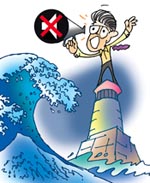State of the Climate in Asia 2024
<p>The World Meteorological Organization’s State of the Climate in Asia 2024 report warns that the region is warming nearly twice as fast as the global average, driving more extreme weather and posing
<p>The World Meteorological Organization’s State of the Climate in Asia 2024 report warns that the region is warming nearly twice as fast as the global average, driving more extreme weather and posing
Scientists Are Building First Worldwide Portrait Of Human Impact That Has Left Just 4% Of The Seas Pristine In 1980, after college, I joined the crew of a sailboat partway through a circumnavigation of the globe. Becalmed and roasting one day during a 21-day crossing of the western Indian Ocean, several of us dived over the side. Within a few swimming strokes, the bobbing hull seemed a toy over my shoulder as I glanced back through my diving mask. Below me, my shadow and the boat's dwindled to the vanishing point in the two-mile-deep water. Human activity seemed nothing when set against the sea itself. Just a few weeks later, on an uninhabited island in a remote part of the Red Sea, I was proved wrong. The shore above the tide line was covered with old light bulbs, apparently tossed from the endless parade of ships over the years. Now scientists are building the first worldwide portrait of such dispersed human impacts on the oceans, revealing a planet-spanning mix of depleted resources, degraded ecosystems and disruptive biological blending as species are moved around the globe by accident and intent. A paper in the February 15 issue of the journal Science is the first effort to map 17 kinds of human ocean impacts like organic pollution, including agricultural runoff and sewage; damage from bottomscraping trawls; and intensive traditional fishing along coral reefs. About 40% of ocean areas are strongly affected, and just 4% pristine, according to the review. Polar seas are in the pristine category, but poised for change. Some human impacts are familiar, like damage to coral reefs and mangrove forests through direct actions like construction and subtler ones like the loss of certain fish that shape ecosystems. Others were a surprise, said Benjamin S Halpern, the lead author and a scientist at the National Center for Ecological Analysis and Synthesis in Santa Barbara, California. He said continental shelves and slopes proved to be the most heavily affected areas, particularly along densely populated coasts. The most widespread human fingerprint is a slow drop in the pH of surface waters around the world as a portion of the billions of tons of carbon dioxide added to the atmosphere from fuel and forest burning each year is absorbed in water, where it forms carbonic acid. That progressive shift in ocean chemistry could eventually disrupt shell-forming plankton and reef-building species, particularly where other impacts, including rising temperatures from human-caused global warming, create simultaneous stresses, many marine biologists say. "I study this stuff all the time and didn't expect the impacts to be as pervasive as we found,' Halpern said. The review provides a baseline necessary for tracking further shifts, he said. It also identifies some unanticipated trouble spots, similar to terrestrial biodiversity "hot spots' that environmental groups have identified over the years. NYT NEWS SERVICE
In 1971, meteorologists Roland Madden and Paul Julian studied weather data from near equatorial Pacific islands. To their surprise, tropospheric winds, pressure and rainfall oscillated with a period of about 40 to 50 days.
A Madden-Julian Oscillation (MJO) is a massive weather event consisting of deep convection coupled with atmospheric circulation, moving slowly eastward over the Indian and Pacific Oceans. Despite its enormous influence on many weather and climate systems worldwide, it has proven very difficult to simulate an MJO because of assumptions about cumulus clouds in global meteorological models.

India sent its first team to the Arctic recently. Two of its members have returned with a variety of samples, some dating back to millions of years. ARCHITA BHATTA spoke with them "We found round

cyclone Gonu has showed up the chinks in India's wind pattern research. The cyclone lashed Oman on June 4, 2007, and delayed monsoon in India by a week. Indian scientists, including the India
Mean-sea-level data from coastal tide gauges in the north Indian Ocean were used to show that low-frequency variability is consistent among the stations in the basin. Statistically significant trends obtained from records longer than 40 years yielded sea-level-rise estimates between 1.06

India's Tsunami Early-Warning System in the Indian Ocean is close to completion, but authorities are clueless about how to circulate alerts. An interim system has been in place since July 2005 and
On December 13, 2006, scientists warned that the Arctic ice is melting at a rate faster than was estimated. The ice has been shrinking steadily over the past 30 years, but now scientists say there's a possibility of an ice-free Arctic in the next few decades.
Monthly and 3-hourly precipitation data from twentieth-century climate simulations by the newest generation of 18 coupled climate system models are analyzed and compared with available observations. The

technology cannot always substitute sound preparedness on the ground; Indonesia learnt it the hard way when a tsunami triggered by an earthquake off the island of Java killed hundreds of people last